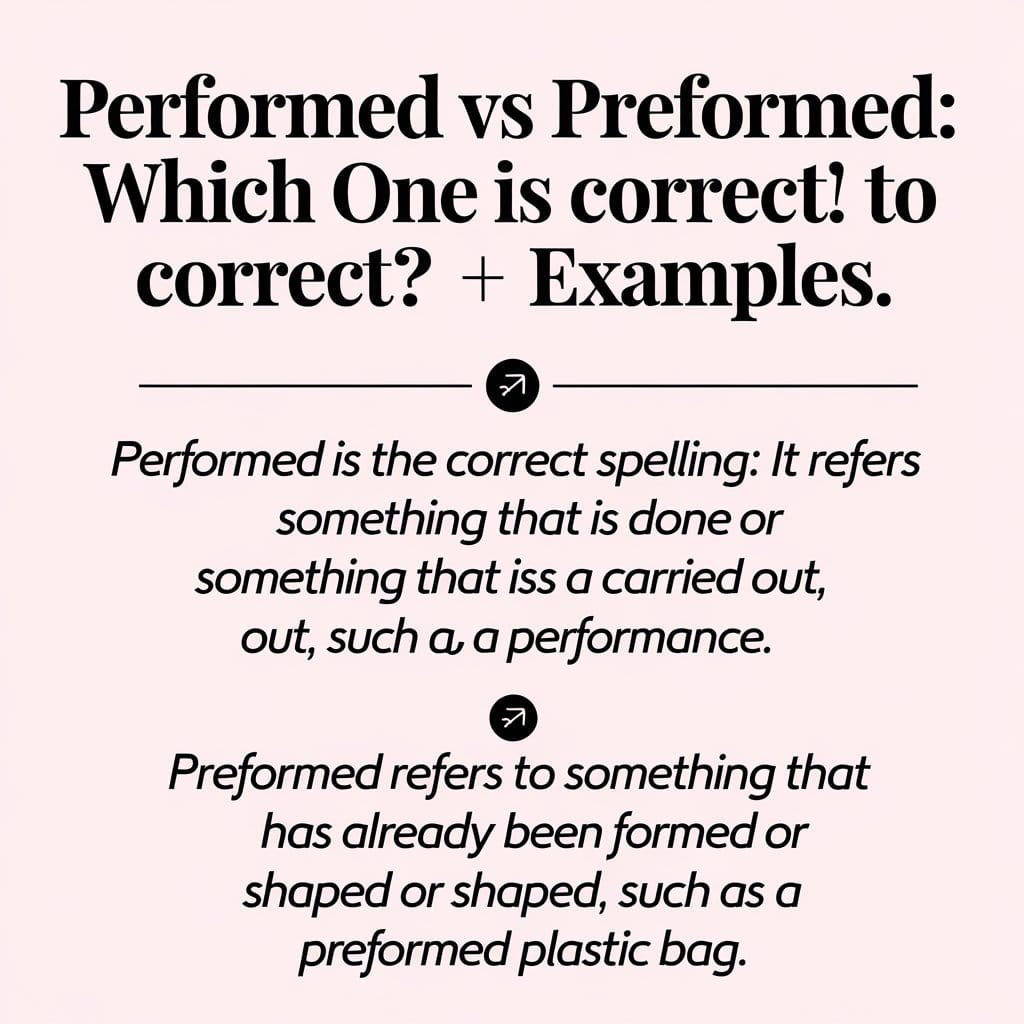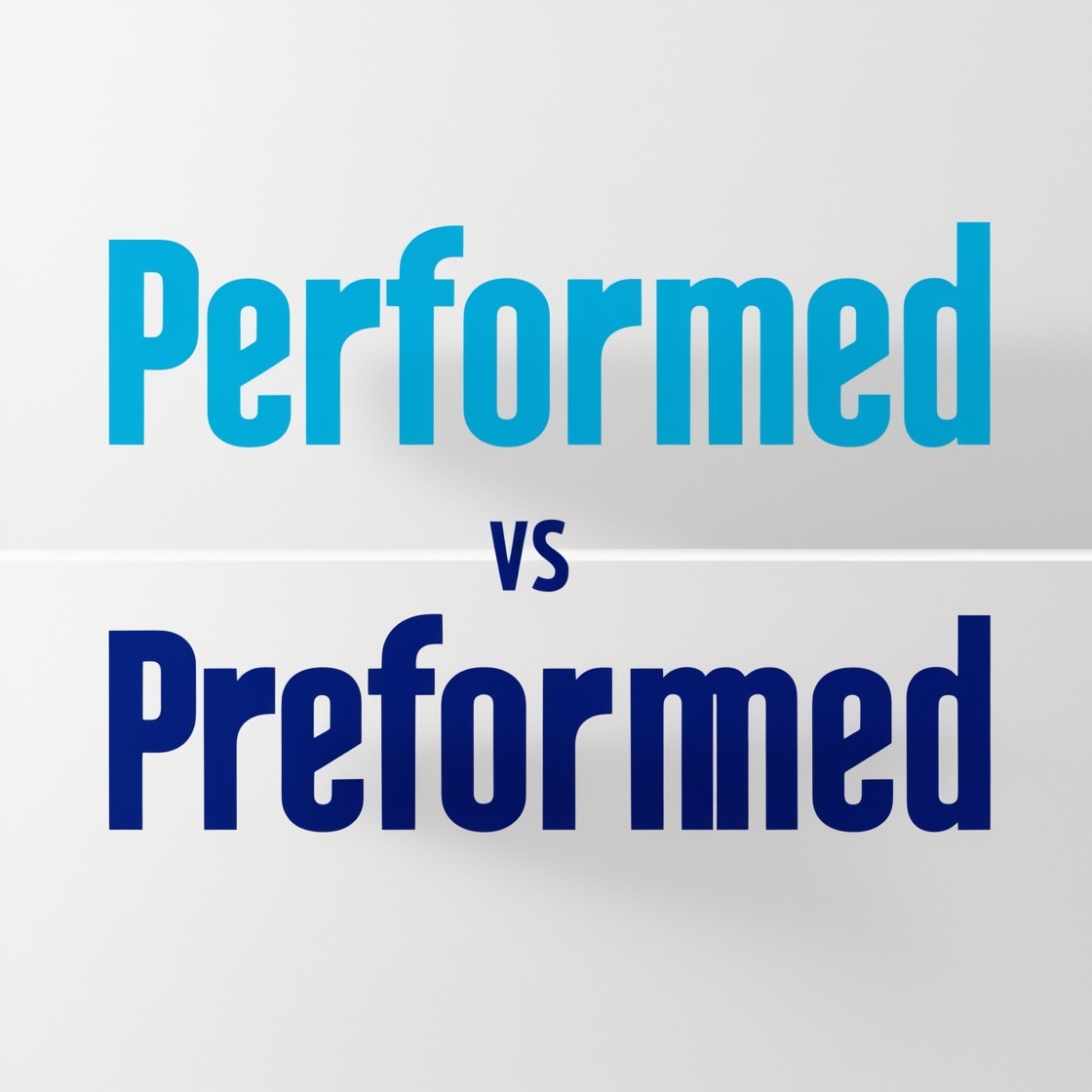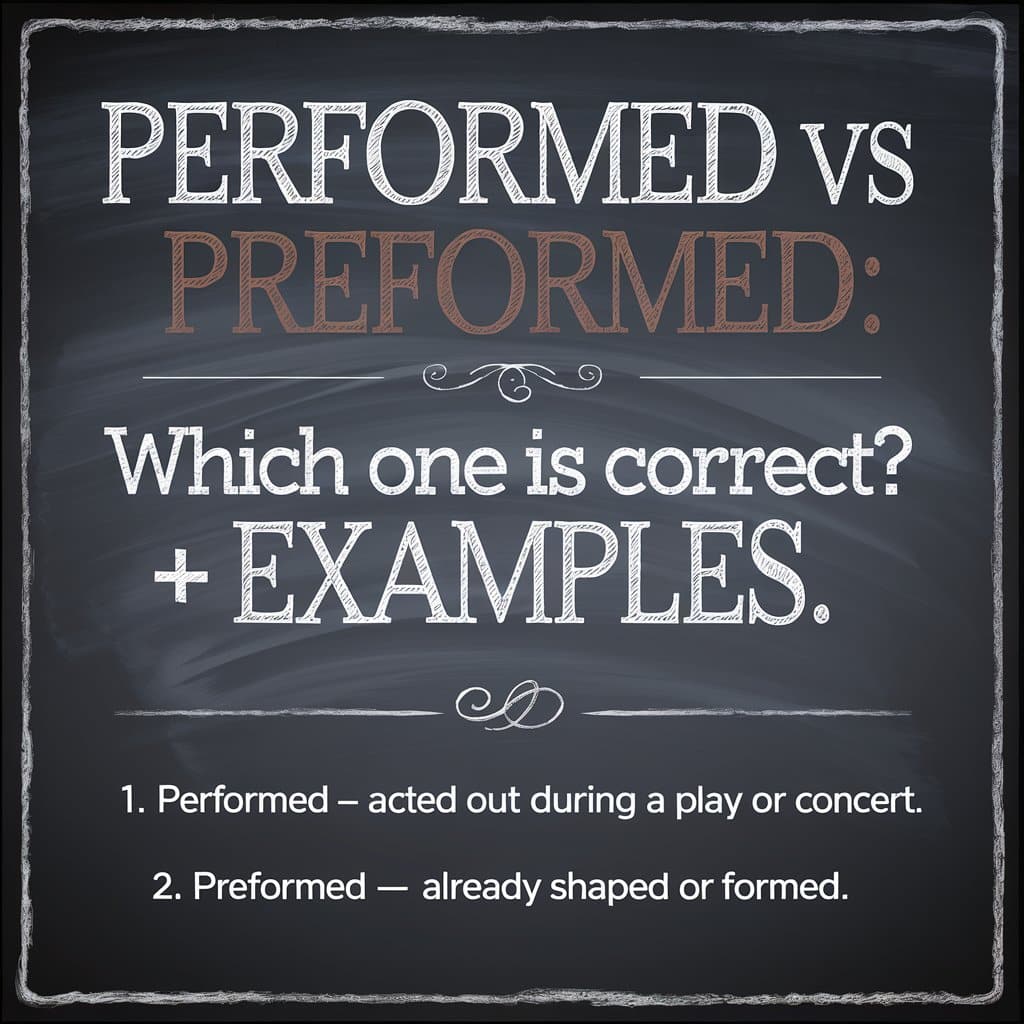When it comes to English language usage, some words can easily trip up even the most seasoned speakers and writers. We use two such words: “performed” and “preformed.” While they may sound similar, they serve different purposes and fit into distinct contexts. Understanding the difference between performed vs preformed is key to ensuring that your writing is accurate and clear.
In this blog post, we will explore the meaning, correct usage, and differences between performed and preformed, providing you with real examples, helpful definitions, and tips to master their use. We will also take a closer look at related terms such as preforming vs performing, preform vs perform, and answer some of the most frequently asked questions around this topic.
What’s the Difference Between Performed and Preformed?
The terms “performed” vs “preformed” often cause confusion due to their similar pronunciation and related roots. However, they carry distinct meanings and we use them in different contexts. Understanding these differences can help you use these words correctly and avoid common mistakes in writing and speech.
1. The Basic Definitions
At the most fundamental level, “performed” and “preformed” differ based on their verb forms and their respective actions.
- Performed is the past tense of the verb “perform”. It refers to carrying out an action, task, or duty. The focus is on the execution of something.
- Example: “She performed a beautiful solo at the concert.”
- “Preformed” is the past tense of “preform”, meaning to shape or prepare something in advance, often before using or assembling it. It implies that someone made or pre-shaped something ahead of time.
- Example: “The company uses preformed parts to assemble the machines faster.”
2. The Core Difference: Action vs. Preparation
The key distinction lies in the nature of the action each word represents:
- Performed involves action, meaning you are carrying out something—an activity, a task, or a performance.
- Example: “The doctor performed a successful surgery.”
- “Preformed”, on the other hand, refers to something that someone has prepared or shaped in advance. It involves preparing an object or material before using it in its final form or purpose.
- Example: “The workers laid down the preformed plastic sheets on the floor as part of the base structure.”
So, while performed is about doing, preformed is about preparing beforehand.
3. The Prefix “Pre-” in Preformed
One of the biggest sources of confusion is the prefix “pre-“ in “preformed”. The prefix “pre-” means before or in advance, suggesting that preformed refers to something created or shaped ahead of time. Note that preformed does not mean completed or executed; it refers to the preparation of something before use.
For example:
- In construction or manufacturing, workers often use preformed objects, where they make components in a factory setting before assembling or installing them.
- Example: “The workers used the preformed concrete blocks in the building’s foundation.”
In contrast, “performed” never implies anything that someone has prepared or set in advance. Instead, it focuses on what someone has done or acted out at a given time.
- Example: “The actor performed brilliantly on-stage last night.”
4. Usage in Different Contexts

People commonly use “performed” and “preformed” in different fields, which often helps clarify their meanings.
Performed:
- In Arts & Entertainment: Refers to the act of executing or presenting a performance. This could be in music, theatre, or dance.
- “The band performed at the festival last weekend.”
- In Professional Settings: Refers to tasks or actions completed, often involving skill or effort.
- “The surgeon performed a successful operation.”
- In Science/Academics: Refers to carrying out experiments, research, or tasks.
- “The researcher performed a series of tests to validate the hypothesis.”
Preformed:
- In Manufacturing: It refers to components or materials that someone has pre-shaped or molded before using them in construction, assembly, or installation.
- “The contractor used preformed metal panels for the building’s exterior.”
- In Construction: It refers to materials that people make ahead of time to save labor and time during the building process.
- “The delivery team brought the preformed concrete slabs to the site, ready to be placed.”
- In Product Design: It refers to elements that people craft in advance for a specific purpose.
- “The designer used preformed templates to ensure accuracy in the product design.”
Read more : Message vs. Messege: Correct Spelling + Examples
5. Visualizing the Difference: Performing vs. Preforming
A useful way to understand the distinction between performed and preformed is by thinking of it in terms of time and process:
- Performed: Involves doing something at the moment, executing a task, or carrying out an action. Think of it as an active process.
- Example: “The dancer performed a solo during the gala.”
- Preformed: Involves preparation that takes place before the main activity or final use. It’s the shaping or structuring of materials or objects ahead of time.
- Example: “The artist used preformed clay to build the base of the sculpture.”
6. A Helpful Comparison Table
Here’s a quick comparison table that summarizes the differences between performed and preformed:
| Aspect | Performed | Preformed |
| Part of Speech | Past tense of the verb “perform” (verb) | Past tense of the verb “preform” (verb) |
| Meaning | To carry out or execute a task or action | To shape or prepare something in advance |
| Focus | Action: What has been done or executed | Preparation: What has been prepared beforehand |
| Use in Sentences | “She performed the task brilliantly.” | “The company used preformed parts to save time.” |
| Common Contexts | Arts, work, science, sports, medicine, etc. | Manufacturing, construction, design, engineering |
7. More Examples of Correct Usage:
Let’s see a few more examples to clarify the differences further:
Performed:
- The scientist performed an experiment to confirm the results.
- He performed his duties with great responsibility.
- The team performed excellently in the final game of the season.
- The actor performed all his stunts without a stunt double.
- The teacher performed a live demonstration of the new technology.
Preformed:
- The preformed sections of the road were easy to install.
- The contractor used preformed insulation for quicker installation.
- The company provided preformed steel beams for the construction project.
- The factory preformed the parts to speed up the assembly process.
- The preformed Mold allowed the sculptor to create consistent shapes.
8. How to Remember the Difference
If you’re ever unsure about which word to use, ask yourself these questions:
- Is this about an action being carried out or executed?
- If yes, use performed.
- Example: “She performed well in the exam.”
- Is this about something that was shaped, melded, or prepared in advance?
- If yes, use preformed.
- Example: “The preformed parts were ready for installation.”
By understanding the specific context in which people use each word, you can confidently choose between “performed” and “preformed”.
Why Do People Mix Up “Performed” and “Preformed”?

People often confuse “performed” and “preformed” due to their similar pronunciation and the fact that both derive from verbs with very similar roots. Additionally, the prefix “pre-” suggests something done ahead of time, which might lead people to assume that “preformed” could also describe something completed or executed.
However, the key difference lies in their application:
- Performed: Refers to actions, processes, or presentations that are carried out.
- Preformed: Refers to something that has been shaped or constructed in advance.
Understanding these distinctions will help you choose the right word for the right context.
Correct Usage of “Performed”
Examples of “Performed” in Different Contexts:
- The surgeon performed the delicate surgery without any complications.
- She performed her duties as manager with exceptional efficiency.
- The orchestra performed a beautiful symphony at the concert hall.
- The actor performed his role so well that he received a standing ovation.
- He performed a thorough analysis of the data before presenting his findings.
- The athletes performed at their best during the national championships.
- The magician performed an amazing trick that left the audience speechless.
- The teacher performed a science experiment to illustrate the concept of chemical reactions.
- The band performed their latest song live for the first time last night.
- The technician performed maintenance on the machines to ensure everything was running smoothly.
- The nurse performed the procedure under the doctor’s supervision.
- The comedian performed a hilarious stand-up routine that had the audience in stitches.
- The team performed exceptionally well during the final match, securing first place.
- She performed the new song flawlessly during the rehearsal.
- The soldiers performed their duties with great Honor during the mission.
- The surgeon performed an emergency operation after the hospital admitted the patient with serious injuries.
- The dancers performed a stunning routine that captivated everyone in the theatre.
- The technician performed a diagnostic check on the car engine.
- The orchestra performed Beethoven’s 5th Symphony at the concert hall.
- The contractor performed the required inspections before proceeding with the construction project.
More Examples:
- The scientist performed a series of experiments to test the hypothesis.
- The pilot performed a flawless landing, even in challenging weather conditions.
- The author performed an in-depth analysis of the historical events in her book.
- The company performed an internal audit to ensure compliance with industry standards.
- The singer performed a beautiful ballad that moved the entire audience.
- He performed a task so well that his manager gave him a special award.
- The doctor performed the diagnostic test to rule out any serious conditions.
- The staff performed admirably in handling the situation during the power outage.
- The musician performed a solo that left the crowd in awe.
- The student performed a detailed experiment in the lab for his final project.
- The researchers performed extensive fieldwork before publishing their findings.
- The technician performed a complete overhaul of the equipment to prevent further issues.
- The actors performed a dramatic scene that charged the audience emotionally.
- The pilot performed a series of manoeuvres during the training exercise.
- The chef performed a culinary demonstration for the guests at the food festival.
- The singer performed in front of a packed arena, thrilling the audience with her voice.
- The workers performed the task of unloading the cargo efficiently and without error.
- The teacher performed a live demonstration of the new math technique.
- The police officer performed a routine check on the vehicle before allowing it to pass.
- The team performed a comprehensive review of the project before the final presentation.
These examples showcase the versatile uses of the verb “performed”. It can refer to carrying out tasks, actions, or duties in various fields such as healthcare, entertainment, sports, education, and more. Whether it’s a professional duty, a scientific experiment, an artistic performance, or a routine action, “performed” describes the execution of actions or processes.
Correct Usage of “Preformed”
Examples of “Preformed” in Different Contexts:
- The preformed concrete slabs were delivered to the construction site.
- The engineer installed the preformed steel rods in the foundation.
- The company specializes in manufacturing preformed metal parts for industrial machines.
- The preformed insulation material made installation much quicker.
- The preformed plastic pieces were melded and then assembled into the final product.
- The architect decided to use preformed wall panels to save time during construction.
- The preformed Molds allowed the workers to quickly create uniform shapes.
- The team used preformed templates to streamline the production process.
- The preformed fiberglass sections were easy to transport and install on site.
- The preformed pipes fit perfectly into the pre-determined slots in the plumbing system.
- The project manager ordered preformed bricks to avoid the Labor costs of manual shaping.
- The preformed nails were ready for use in the packaging process.
- Workers installed the preformed rubber gaskets along the edges to prevent leaks.
- The factory received the preformed sheets of metal, already cut to the desired size.
- The sculptor used the preformed foam pieces to create a mold for the sculpture.
- The team arranged the preformed wires in a bundle for easier handling during assembly.
- The company uses preformed components to expedite the manufacturing of custom electronics.
- The preformed insulation panels were installed in the attic to improve energy efficiency.
- The preformed cardboard inserts protected the delicate parts during shipping.
- The workers used preformed cement blocks to quickly build the retaining wall.
Another Examples:
- The artist chose to use preformed clay shapes to create a uniform structure for the sculpture.
- The preformed concrete arch was ready to be installed as part of the bridge construction.
- The factory produced preformed glass panels to fit into the window frames.
- The preformed fabric pieces were sewn together to create the final product.
- The designer selected preformed leather patches for their clothing line.
- The preformed frames allowed the carpenter to quickly assemble the doors.
- The preformed wood beams were easily integrated into the house’s framework.
- The preformed templates were applied to the metal sheets for precision cutting.
- The preformed carpets were laid down throughout the office space in one day.
- The company manufactures preformed parts for the aerospace industry to reduce assembly time.
- The preformed gel capsules were filled with the medication before packaging.
- The preformed bricks were neatly stacked, ready to be laid into the structure.
- The preformed air ducts were connected with minimal effort during the HVAC installation.
- The preformed wiring harness was installed in the vehicle assembly line.
- The factory workers had to assemble the preformed sections of the pipeline on site.
- Workers used the preformed aluminum panels to cover the exterior of the building.
- The team cut the preformed metal sheets into smaller sections for use in the vehicle’s body.
- Manufacturers used the preformed polymer beads to create lightweight parts for the product.
- The technicians inserted the preformed plastic tubing into place without needing further adjustment.
These examples show how we use “preformed” to describe something that someone has shaped, melded, or constructed in advance, typically for further use in industrial, construction, or manufacturing contexts. The term emphasizes the idea of preparation or pre-assembly, highlighting efficiency and time-saving benefits.
You may also like : Moment Vs Momment: Spelling + Definition + Usage
Perform vs Preform: Understanding the Roots
When it comes to “perform” and “preform”, the confusion often arises because of their similar sound and the subtle differences in their meanings. To better understand how and when to use these two words correctly, it’s helpful to delve into their roots and etymology. This will not only clarify their distinctions but also make it easier to remember the appropriate contexts for each.
The Origins of “Perform” and “Preform”
Both “perform” and “preform” have their roots in Latin, but they evolved in slightly different ways, which is reflected in their modern meanings.
Perform: The Root Meaning
The word “perform” comes from the Latin verb “perform are”, which means “to complete” or “to accomplish”. The Latin “per-“ is a prefix meaning “through” or “completely,” and “form are” comes from the word “forma”, meaning “shape” or “structure.” Together, “perform are” originally meant to shape or complete something thoroughly.
Over time, “perform” shifted in meaning to refer to the execution of a task or the carrying out of an action—not just completing something physically but also doing it in an active, often skilled way. In modern English, “perform” is used to describe a range of activities from completing tasks to giving a public performance.
- Example: “She performed a difficult surgery with precision.”
So, “perform” is about doing or executing something, whether it’s a task, an action, or a performance.
Preform: The Root Meaning
On the other hand, “preform” is built from the Latin “pare-“, meaning “before”, and “form are”, meaning “to shape”. The “pare-“ prefix suggests that something is done before a specific event or purpose. Thus, “preform are” meant “to shape before” or “to prepare in advance”.
In modern usage, “preform” refers to something that is shaped, moulded, or prepared in advance for a specific purpose. It is not about execution or action but about preparing something to be used later.
- Example: “The company preforms parts that are then assembled on-site.”
So, “preform” is about preparing or shaping something ahead of time.
How Their Roots Reflect Their Modern Usage
By understanding the Latin roots of “perform” and “preform”, we can better grasp their modern meanings and applications.
- “Perform” is about executing an action—whether it’s carrying out a task, presenting something, or performing in front of an audience. Its root, “perform are”, suggests the act of completing or finishing an action.
- “Preform”, however, refers to something that is created or shaped in advance. It focuses on the preparation phase before an object or material is used for its intended purpose. The “pare-“ prefix gives us the hint that it’s about something done before an action takes place.
Breaking Down Perform vs Preform
To understand their subtle differences more clearly, let’s break them down into categories: action, preparation, and timeframe.
Action:
- Perform: Involves carrying out or executing an action or task. This could be anything from a job, an activity, or a performance.
- Example: “The actor performed an emotional scene on stage.”
- Preform: Involves shaping or preparing something in advance before it is used or assembled.
- Example: “The company preforms parts for the car assembly line.”
Preparation:
- Perform: No preparation is implied here—performing is the action itself, done in the present moment.
- Example: “She performed a delicate procedure during the surgery.”
- Preform: Implies that the preparation has already been done—something is pre-shaped or pre-assembled before it is put into its final context or used.
- Example: “The preformed concrete slabs were delivered to the site ready for installation.”
Timeframe:
- Perform: Refers to an action that is happening now or has already been executed. It’s focused on the present or past.
- Example: “He performed the task with great care.”
- Preform: Refers to something that is done before the action or usage—in the past or ahead of time.
- Example: “The parts were preformed and waiting to be assembled.”
Examples of Perform vs Preform in Action
Here are some practical examples that highlight their meanings more clearly:
Perform:
- The singer performed a beautiful aria at the opera.
- The technician performed a diagnostic test on the computer.
- The actor performed a monologue that left the audience in awe.
- The athletes performed exceptionally well in the competition.
- The surgeon performed the operation with skill and precision.
Preform:
- The manufacturer preforms plastic parts before they are sent for final assembly.
- The architect used preformed blueprints for the construction of the building.
- The engineer preformed the metal sheets to fit the custom design.
- The factory preforms components that are later used in final product assembly.
- The sculptor preformed the clay to create the initial shape before refining the details.
The Role of Prefixes in Understanding the Difference
Understanding the prefixes in these words can give you an easy way to distinguish them:
- “Pre-“ means before. So, when someone preforms something, they make or shape it before using it.
- “Per-“ means through or completely. When you perform an action, it’s something you carry out thoroughly or completely.
By remembering these roots, you can quickly identify when you’re talking about preparation (preform) versus execution (perform).
Common Mistakes and How to Avoid Them

It’s easy to mix up perform and preform because they sound similar, but their meanings are quite distinct. Here are some common mistakes and tips to avoid them:
- Mistake: Using preform when referring to an action or performance.
- Incorrect: “She preformed on stage.”
- Correct: “She performed on stage.”
- Mistake: Using perform when referring to something that’s been prepared in advance.
- Incorrect: “The company performed the parts ahead of time.”
- Correct: “The company preformed the parts ahead of time.”
By understanding their roots and keeping the key distinction—performance (perform) vs. preparation (preform)—you’ll be able to use these words with confidence.
Idioms and Expressions Involving “Perform”
People use the verb “perform” in several popular idioms and expressions. Understanding these expressions can enrich your vocabulary and help you communicate more naturally.
- “Perform at your best” – To do something to the best of your ability.
- Example: “I always try to perform at my best in every project.”
- “Perform miracles” – To achieve something seemingly impossible.
- Example: “She performed miracles with her ability to solve complex problems.”
- “Perform a role” – To act or play a specific part in something (e.g., in a play, a job).
- Example: “He performed the role of Hamlet flawlessly in the play.”
These idioms highlight how we can apply “perform” to various situations, from actions to accomplishments, demonstrating its versatility.
The Word Formation of “Perform”
The word perform has several derivatives that all stem from the same root. These related forms have specific meanings and uses in the English language.
| Word Form | Definition | Example |
| Performer | A person who performs or carries out an action. | “The performer captivated the audience with her talent.” |
| Performance | The act of performing or the result of a performance. | “The performance was highly praised by critics.” |
| Performing | The present continuous form of perform. | “She is performing at the concert tonight.” |
| Performed | The past tense of perform. | “He performed the task efficiently.” |
People use these word forms in various contexts, and understanding how they work can improve your writing and speaking.
Alternatives to “Perform”
While people commonly use “perform,” you can choose from many alternatives depending on the context. Some of these alternatives are:
- Execute – To carry out or put into effect (e.g., “The contractor executed the plans flawlessly”).
- Carry out – To complete or fulfill (e.g., “He carried out his duties with diligence”).
- Conduct – To organize or lead (e.g., “She conducted the meeting smoothly”).
- Accomplish – To achieve or complete (e.g., “They accomplished the task ahead of schedule”).
- Achieve – To bring about through effort (e.g., “He achieved his goals after years of hard work”).
By using these synonyms, you can avoid repetition and enhance the clarity and variety of your language.
How “Performed” Can Be Used in Different Contexts
Let’s now explore how we can apply “performed” in various scenarios:
In Professional Settings
- Example: “The surgeon performed the delicate operation successfully.”
- Example: “The team performed well under stressful conditions.”
Performed relates to the execution of tasks requiring expertise, precision, or skill.
In Arts and Entertainment
- Example: “The orchestra performed a beautiful symphony.”
- Example: “The actor performed his lines with great emotion.”
Here, performed refers to artistic acts, including performances in theatre, music, and dance.
In Education and Assessment
- Example: “The student performed well in his final exam.”
- Example: “She performed admirably in the group project.”
In academic settings, we often use “performed” to evaluate how well someone completes a task or assignment.
Preformed in Literature: An Artistic Exploration
In the realm of literature, preformed often takes on a more metaphorical meaning. Writers sometimes use the idea of preformed things to refer to ideas, structures, or narratives that they shape or set up in advance.
- Symbolism: Just like a preformed object, symbols in literature are often prepared and used to represent deeper meanings.
- Character Development: Characters may be preformed or pre-designed by the author before they are fleshed out in the story.
Performed in Society: Cultural Implications
In society, performed actions take on a cultural dimension. Whether it’s in politics, social behaviour, or public life, people often “perform” roles according to societal expectations. A preformed social role can refer to stereotypes or expectations that society has already shaped for certain individuals.
- Public Speaking: Politicians, for example, often perform according to expectations, delivering speeches that resonate with their audiences.
- Social Roles: From parents to professionals, people are expected to perform roles that society has preformed for them.
Preformed vs Performed: A Recap
The main difference between performed and preformed is straightforward:
- Performed refers to an action that has been carried out or executed.
- Preformed refers to something that has been shaped or prepared in advance.
By understanding these nuances, you can confidently use each word in the appropriate context, whether you’re writing a report, preparing a speech, or simply communicating more clearly.
You can never miss it : Reinforce Vs Reenforce : 10 Differences + Examples
FAQs: Common Questions About “Performed” and “Preformed”
Is it perform or preform?
The correct usage depends on the context:
- Perform refers to executing or carrying out an action.
- Preform refers to shaping or preparing something in advance.
What does performed mean?
“Performed” is the past tense of “perform” and refers to something that someone has done, executed, or presented.
Is preformed the same as performed?
No, “preformed” refers to something that someone has made or shaped ahead of time, while “performed” refers to something that someone has executed or acted out.
Conclusion: Mastering the Difference Between Performed and Preformed
Understanding the difference between performed and preformed is crucial for clear, effective communication. While both words sound similar, their meanings and applications vary widely, from artistic performances to pre-made materials in manufacturing. By carefully considering the context, you’ll be able to choose the right word every time.
So, whether you’re performing a task at work or discussing preformed concrete in construction, the proper usage of these terms will help you convey your message more precisely and confidently.

John David is an experienced blogger at Grammar Blend, passionate about language and communication. With a keen eye for grammar and clarity, he shares practical tips and tools to help readers improve their writing skills. His insightful articles make grammar accessible and engaging for learners of all levels.







